It’s often said around the dog training world when discussing verbal communication with dogs, “it doesn’t matter what you say, it’s how you say it.” There is some truth to the idea that our language is of no significance to dogs. But, recent advancements in the use of MRI technologies to study how dogs think are telling a different story. For instance, a study that was conducted at Eotvos Lorand University in Budapest and that was recently covered in this New York Times article, shows that dogs certainly do understand verbal language. What we say is actually just as important as how we say it.
Part of how we anthropomorphize our experiences with dogs is that we hold conversations with them. We ask them how their day has been. We challenge them on what they were thinking when they ripped apart a pillow. And if we’re focused on being engaging during training, we’re giving continual encouragement with sentences such as, “You’re so smart… you’ve got it… do it again… let’s see it.” There’s truly nothing wrong with any of this. In fact, it’s good. It builds engagement and attraction between people and dogs and brings a level of fun and character to the relationship that otherwise wouldn’t exist.
That said, there are definitely times when clarity is key. Marking a moment so your dog knows that you liked exactly what they did at the specific moment they did it (“YES!”) vs. providing on-going positive reinforcement to encourage your dog to build duration on a behavior (“Goooooood…”) are very different communications and require very different language in both tone and vocabulary to be communicated as effectively as possible. This is just one example.
A prime example of a common communication breakdown between people and dogs that shows where the specificity of words is important is with the “down” command. “Down” usually means, “lay all the way down on the floor,” but it is often also used to communicate, “get off the couch” or “stop jumping on me.” This misuse can not only create frustration among humans, it can be very confusing to dogs. Dogs that are trained on “down” and “off” tend to preform these tasks much better. Similarly, people might say, “sit” to connote, “I’d like you to please sit.” When they are angry with their dog, it comes out as “Sit Down!” Asking for the same action in very different contexts is counterproductive in dog training. Words (and tone) matter – for people and dogs.
Things to think about when deciding on which words you want to use with your dog for specific commands:
- Words with one or two syllables are often easy to remember and precise to say, but longer commands aren’t necessarily bad. “Go to bed” works just fine when you want your dog to lay in their place.
- Consider using a foreign language. Not only does this bring clarity to the dog who will likely never hear you say their commands in everyday conversation, it also helps handlers with being intentional in giving commands. This list is very helpful in explaining various commands in multiple languages. If you really want to be creative, consider training your dog in Klingon, Latin, or something that you make up entirely on your own.
- Words that signify something specific to the dog must be consistent. These include markers, commands, and both positive and negative reinforcers. Again, conversations with your dog aren’t bad, but being clear when you want your dog to do or know something specific is important.
- Lastly, while this post is about what you say, don’t forget to practice how you say it. This post from about a month ago covers that well.
If you’d like to know more about how studies such as the one listed here get dogs to lay still for MRIs… this TED Talk is well worth a watch.

